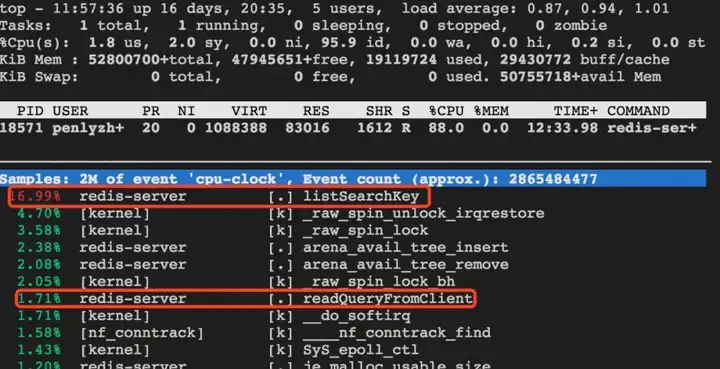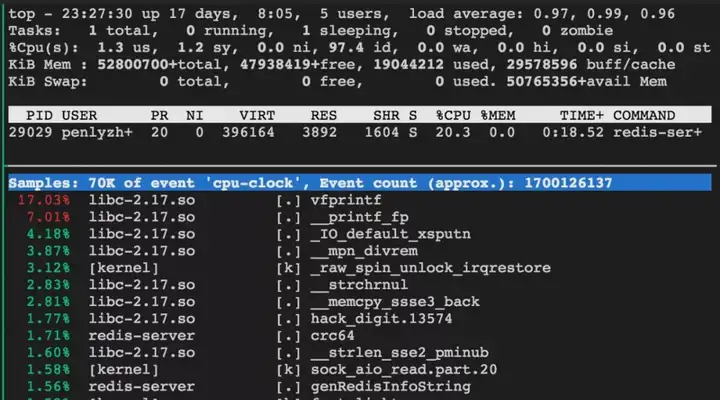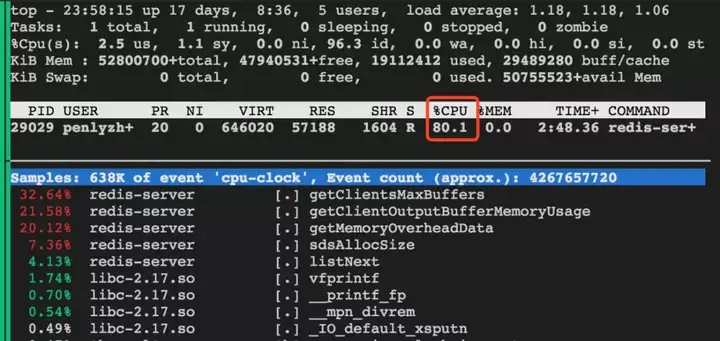作者介绍
张鹏义,腾讯云数据库高级工程师,曾参与华为 Taurus 分布式数据研发及腾讯 CynosDB for PG 研发工作,现从事腾讯云 Redis 数据库研发工作。
我们在使用 Redis 时,总会碰到一些 redis-server 端 CPU 及内存占用比较高的问题。下面以几个实际案例为例,来讨论一下在使用 Redis 时容易忽视的几种情形。
一、短连接导致 CPU 高
某用户反映 QPS 不高,从监控看 CPU 确实偏高。既然 QPS 不高,那么 redis-server 自身很可能在做某些清理工作或者用户在执行复杂度较高的命令,经排查无没有进行 key 过期删除操作,没有执行复杂度高的命令。上机器对 redis-server 进行 perf 分析,发现函数 listSearchKey 占用 CPU 比较高,分析调用栈发现在释放连接时会频繁调用 listSearchKey,且用户反馈说是使用的短连接,所以推断是频繁释放连接导致 CPU 占用有所升高。
1、对比实例
下面使用 redis-benchmark 工具分别使用长连接和短连接做一个对比实验,redis-server 为社区版 4.0.10 。
1 )长连接测试
使用 10000 个长连接向 redis-server 发送 50w 次 ping 命令:
./redis-benchmark -h host -p port -t ping -c 10000 -n 500000 -k 1 ( k=1 表示使用长连接,k=0 表示使用短连接)
最终 QPS:
PING_INLINE: 92902.27 requests per second
PING_BULK: 93580.38 requests per second
对 redis-server 分析,发现占用 CPU 最高的是 readQueryFromClient,即主要是在处理来自用户端的请求。
2 )短连接测试
使用 10000 个短连接向 redis-server 发送 50w 次 ping 命令:
./redis-benchmark -h host -p port -t ping -c 10000 -n 500000 -k 0
最终 QPS:
PING_INLINE: 15187.18 requests per second
PING_BULK: 16471.75 requests per second
对 redis-server 分析,发现占用 CPU 最高的确实是 listSearchKey,而 readQueryFromClient 所占 CPU 的比例比 listSearchKey 要低得多,也就是说 CPU 有点“不务正业”了,处理用户请求变成了副业,而搜索 list 却成为了主业。所以在同样的业务请求量下,使用短连接会增加 CPU 的负担。

从 QPS 上看,短连接与长连接差距比较大,原因来自两方面:
- 每次重新建连接引入的网络开销。
- 释放连接时,redis-server 需消耗额外的 CPU 周期做清理工作。(这一点可以尝试从 redis-server 端做优化)
2、Redis 连接释放
我们从代码层面来看下 redis-server 在用户端发起连接释放后都会做哪些事情,redis-server 在收到用户端的断连请求时会直接进入到 freeClient。
void freeClient(client *c) {
listNode *ln;
/* .........*/
/* Free the query buffer */
sdsfree(c->querybuf);
sdsfree(c->pending_querybuf);
c->querybuf = NULL;
/* Deallocate structures used to block on blocking ops. */
if (c->flags & CLIENT_BLOCKED) unblockClient(c);
dictRelease(c->bpop.keys);
/* UNWATCH all the keys */
unwatchAllKeys(c);
listRelease(c->watched_keys);
/* Unsubscribe from all the pubsub channels */
pubsubUnsubscribeAllChannels(c,0);
pubsubUnsubscribeAllPatterns(c,0);
dictRelease(c->pubsub_channels);
listRelease(c->pubsub_patterns);
/* Free data structures. */
listRelease(c->reply);
freeClientArgv(c);
/* Unlink the client: this will close the socket, remove the I/O
* handlers, and remove references of the client from different
* places where active clients may be referenced. */
/* redis-server 维护了一个 server.clients 链表,当用户端建立连接后,新建一个 client 对象并追加到 server.clients 上,
当连接释放时,需求从 server.clients 上删除 client 对象 */
unlinkClient(c);
/* ...........*/
}
void unlinkClient(client *c) {
listNode *ln;
/* If this is marked as current client unset it. */
if (server.current_client == c) server.current_client = NULL;
/* Certain operations must be done only if the client has an active socket.
* If the client was already unlinked or if it's a "fake client" the
* fd is already set to -1. */
if (c->fd != -1) {
/* 搜索 server.clients 链表,然后删除 client 节点对象,这里复杂为 O(N) */
ln = listSearchKey(server.clients,c);
serverAssert(ln != NULL);
listDelNode(server.clients,ln);
/* Unregister async I/O handlers and close the socket. */
aeDeleteFileEvent(server.el,c->fd,AE_READABLE);
aeDeleteFileEvent(server.el,c->fd,AE_WRITABLE);
close(c->fd);
c->fd = -1;
}
/* ......... */
所以在每次连接断开时,都存在一个 O(N)的运算。对于 redis 这样的内存数据库,我们应该尽量避开 O(N)运算,特别是在连接数比较大的场景下,对性能影响比较明显。虽然用户只要不使用短连接就能避免,但在实际的场景中,用户端连接池被打满后,用户也可能会建立一些短连接。
3、优化
从上面的分析看,每次连接释放时都会进行 O(N)的运算,那能不能降复杂度降到 O(1)呢?
这个问题非常简单,server.clients 是个双向链表,只要当 client 对象在创建时记住自己的内存地址,释放时就不需要遍历 server.clients。接下来尝试优化下:
client *createClient(int fd) {
client *c = zmalloc(sizeof(client));
/* ........ */
listSetFreeMethod(c->pubsub_patterns,decrRefCountVoid);
listSetMatchMethod(c->pubsub_patterns,listMatchObjects);
if (fd != -1) {
/* client 记录自身所在 list 的 listNode 地址 */
c->client_list_node = listAddNodeTailEx(server.clients,c);
}
initClientMultiState(c);
return c;
}
void unlinkClient(client *c) {
listNode *ln;
/* If this is marked as current client unset it. */
if (server.current_client == c) server.current_client = NULL;
/* Certain operations must be done only if the client has an active socket.
* If the client was already unlinked or if it's a "fake client" the
* fd is already set to -1. */
if (c->fd != -1) {
/* 这时不再需求搜索 server.clients 链表 */
//ln = listSearchKey(server.clients,c);
//serverAssert(ln != NULL);
//listDelNode(server.clients,ln);
listDelNode(server.clients, c->client_list_node);
/* Unregister async I/O handlers and close the socket. */
aeDeleteFileEvent(server.el,c->fd,AE_READABLE);
aeDeleteFileEvent(server.el,c->fd,AE_WRITABLE);
close(c->fd);
c->fd = -1;
}
/* ......... */
优化后短连接测试
使用 10000 个短连接向 redis-server 发送 50w 次 ping 命令:
./redis-benchmark -h host -p port -t ping -c 10000 -n 500000 -k 0
最终 QPS:
PING_INLINE: 21884.23 requests per second
PING_BULK: 21454.62 requests per second
与优化前相比,短连接性能能够提升 30+%,所以能够保证存在短连接的情况下,性能不至于太差。
二、info 命令导致 CPU 高
有用户通过定期执行 info 命令监视 redis 的状态,这会在一定程度上导致 CPU 占用偏高。频繁执行 info 时通过 perf 分析发现 getClientsMaxBuffers、getClientOutputBufferMemoryUsage 及 getMemoryOverheadData 这几个函数占用 CPU 比较高。通过 Info 命令,可以拉取到 redis-server 端的如下一些状态信息(未列全):
client
connected_clients:1
client_longest_output_list:0 // redis-server 端最长的 outputbuffer 列表长度
client_biggest_input_buf:0. // redis-server 端最长的 inputbuffer 字节长度
blocked_clients:0
Memory
used_memory:848392
used_memory_human:828.51K
used_memory_rss:3620864
used_memory_rss_human:3.45M
used_memory_peak:619108296
used_memory_peak_human:590.43M
used_memory_peak_perc:0.14%
used_memory_overhead:836182 // 除 dataset 外,redis-server 为维护自身结构所额外占用的内存量
used_memory_startup:786552
used_memory_dataset:12210
used_memory_dataset_perc:19.74%
为了得到 client_longest_output_list、client_longest_output_list 状态,需要遍历 redis-server 端所有的 client, 如 getClientsMaxBuffers 所示,可能看到这里也是存在同样的 O(N)运算。
void getClientsMaxBuffers(unsigned long *longest_output_list,
unsigned long *biggest_input_buffer) {
client *c;
listNode *ln;
listIter li;
unsigned long lol = 0, bib = 0;
/* 遍历所有 client, 复杂度 O(N) */
listRewind(server.clients,&li);
while ((ln = listNext(&li)) != NULL) {
c = listNodeValue(ln);
if (listLength(c->reply) > lol) lol = listLength(c->reply);
if (sdslen(c->querybuf) > bib) bib = sdslen(c->querybuf);
}
*longest_output_list = lol;
*biggest_input_buffer = bib;
}
为了得到 used_memory_overhead 状态,同样也需要遍历所有 client 计算所有 client 的 outputBuffer 所占用的内存总量,如 getMemoryOverheadData 所示:
struct redisMemOverhead *getMemoryOverheadData(void) {
/* ......... */
mem = 0;
if (server.repl_backlog)
mem += zmalloc_size(server.repl_backlog);
mh->repl_backlog = mem;
mem_total += mem;
/* ...............*/
mem = 0;
if (listLength(server.clients)) {
listIter li;
listNode *ln;
/* 遍历所有的 client, 计算所有 client outputBuffer 占用的内存总和,复杂度为 O(N) */
listRewind(server.clients,&li);
while((ln = listNext(&li))) {
client *c = listNodeValue(ln);
if (c->flags & CLIENT_SLAVE)
continue;
mem += getClientOutputBufferMemoryUsage(c);
mem += sdsAllocSize(c->querybuf);
mem += sizeof(client);
}
}
mh->clients_normal = mem;
mem_total+=mem;
mem = 0;
if (server.aof_state != AOF_OFF) {
mem += sdslen(server.aof_buf);
mem += aofRewriteBufferSize();
}
mh->aof_buffer = mem;
mem_total+=mem;
/* ......... */
return mh;
}
实验
从上面的分析知道,当连接数较高时( O(N)的 N 大),如果频率执行 info 命令,会占用较多 CPU。1 )建立一个连接,不断执行 info 命令
func main() {
c, err := redis.Dial("tcp", addr)
if err != nil {
fmt.Println("Connect to redis error:", err)
return
}
for {
c.Do("info")
}
return
}
实验结果表明,CPU 占用仅为 20%左右。

2 )建立 9999 个空闲连接,及一个连接不断执行 info
func main() {
clients := []redis.Conn{}
for i := 0; i < 9999; i++ {
c, err := redis.Dial("tcp", addr)
if err != nil {
fmt.Println("Connect to redis error:", err)
return
}
clients = append(clients, c)
}
c, err := redis.Dial("tcp", addr)
if err != nil {
fmt.Println("Connect to redis error:", err)
return
}
for {
_, err = c.Do("info")
if err != nil {
panic(err)
}
}
return
}
实验结果表明 CPU 能够达到 80%,所以在连接数较高时,尽量避免使用 info 命令。

3 ) pipeline 导致内存占用高
有用户发现在使用 pipeline 做只读操作时,redis-server 的内存容量偶尔也会出现明显的上涨, 这是对 pipeline 的使不当造成的。下面先以一个简单的例子来说明 Redis 的 pipeline 逻辑是怎样的。
下面通过 golang 语言实现以 pipeline 的方式从 redis-server 端读取 key1、key2、key3。
import (
"fmt"
"http://github.com/garyburd/redigo/redis"
)
func main(){
c, err := redis.Dial("tcp", "127.0.0.1:6379")
if err != nil {
panic(err)
}
c.Send("get", "key1") //缓存到 client 端的 buffer 中
c.Send("get", "key2") //缓存到 client 端的 buffer 中
c.Send("get", "key3") //缓存到 client 端的 buffer 中
c.Flush() //将 buffer 中的内容以一特定的协议格式发送到 redis-server 端
fmt.Println(redis.String(c.Receive()))
fmt.Println(redis.String(c.Receive()))
fmt.Println(redis.String(c.Receive()))
}
而此时 server 端收到的内容为:
*2 $3 get $4 key1 *2 $3 get $4 key2 *2 $3 get $4 key3
下面是一段 redis-server 端非正式的代码处理逻辑,redis-server 端从接收到的内容依次解析出命令、执行命令、将执行结果缓存到 replyBuffer 中,并将用户端标记为有内容需要写出。等到下次事件调度时再将 replyBuffer 中的内容通过 socket 发送到 client,所以并不是处理完一条命令就将结果返回用户端。
readQueryFromClient(client* c) {
read(c->querybuf) // c->query="*2 $3 get $4 key1 *2 $3 get $4 key2 *2 $3 get $4 key3 "
cmdsNum = parseCmdNum(c->querybuf) // cmdNum = 3
while(cmsNum--) {
cmd = parseCmd(c->querybuf) // cmd: get key1、get key2、get key3
reply = execCmd(cmd)
appendReplyBuffer(reply)
markClientPendingWrite(c)
}
}
考虑这样一种情况:
如果用户端程序处理比较慢,未能及时通过 c.Receive()从 TCP 的接收 buffer 中读取内容或者因为某些 BUG 导致没有执行 c.Receive(),当接收 buffer 满了后,server 端的 TCP 滑动窗口为 0,导致 server 端无法发送 replyBuffer 中的内容,所以 replyBuffer 由于迟迟得不到释放而占用额外的内存。当 pipeline 一次打包的命令数太多,以及包含如 mget、hgetall、lrange 等操作多个对象的命令时,问题会更突出。
小结
上面几种情况,都是非常简单的问题,没有复杂的逻辑,在大部分场景下都不算问题,但是在一些极端场景下要把 Redis 用好,开发者还是需要关注这些细节。建议:- 尽量不要使用短连接;
- 尽量不要在连接数比较高的场景下频繁使用 info ;
- 使用 pipeline 时,要及时接收请求处理结果,且 pipeline 不宜一次打包太多请求。
江湖召集令
9 月 27 日-11 月 6 日,腾讯云数据库王者挑战赛(点击查看详情) 等你挑战!花几分钟参加比赛免费将☟☟抱回家!- MacBook/iPhone 11/AirPods
- 25 台 Kindle
- 8 万元腾讯云创业基金
- MySQL 之父 Michael Widenius 面对面交流
拥有与殿堂级大神的合影和亲笔签名书籍的你, 能让隔壁码农羡慕到流泪!
转发下方海报参与活动可以获得腾讯公仔和腾讯云数据库无门槛代金券,详情请添加海报上机器人二维码咨询。

比赛详情&报名入口
请扫下方二维码

点击享受 Redis 入门体验